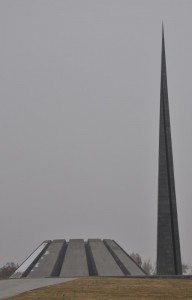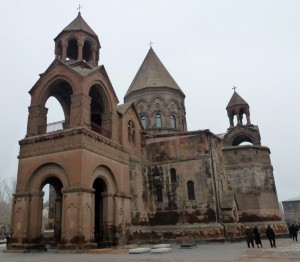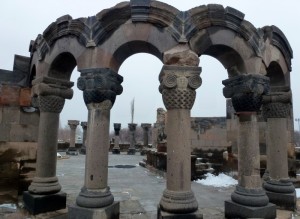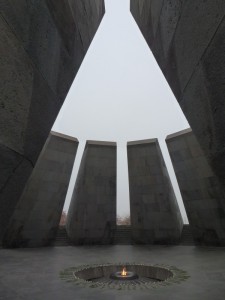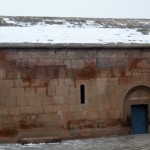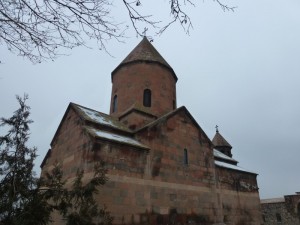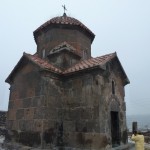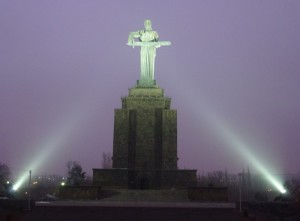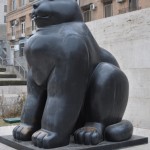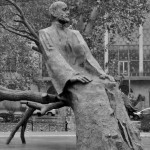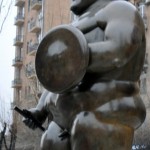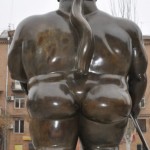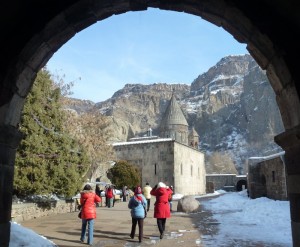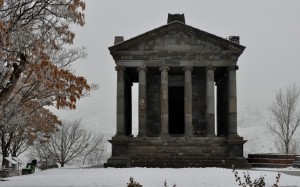Armenia, Georgia and Azerbaijan, occupying a mountainous zone on the southern flank of the Caucasus Mountains, sit on one of the earth’s greatest crossroads. After spending six days roaming about on my own in Yerevan, Southern Armenia and Karabakh, I joined my friends from Hong Kong and spent four days visiting main attractions in Armenia including many remarkable churches and monasteries at Echmiatsin,
Zvartnots, Haghpat, Geghard and Lake Sevan before crossing to Georgia.
Day 7 (Sunday, December 18): Yerevan
Today my group tour began with my nine friends arriving from Hong Kong via Moscow. We stayed in a five-star hotel right on the Republic Square. A real treat for a backpacker!
Yerevan was founded in 782 BC when King Argishti I of Urartu built the Erebuni fortress there. The city is not touristy and I find it resembling a second/third tier soviet city. Nonetheless, I understand the city springs to life in the summer with concerts and performances, numerous trendy cafes and restaurants as well as many hidden treasures!
My friends were energetic and we had a full day programme though they had spent the night before on the plane and at the Moscow airport.
We had an excellent lively and knowledgeable guide, Irina and a polite young driver. Our first stop was the Holy Echmiadzin (meaning “the place where the Only Begotten descended”), the Vatican of the Armenian Apostolic Church. It is the oldest state-built church in the world. The original vault was built in 301-303 by St Gregory the Illuminator (the first Catholicos (universal bishop) of the Armenian Church) when he saw a beam of light fall to the earth in a divine vision. Echmiadzin was the capital of Armenia from 180 to 340. Archaeological findings suggest that the cathedral was built on a former pagan shrine when Armenia followed Zoroastrianism.
Echmiadzin is one of the holiest cities in Armenia. The Palace of the Catholicos is in front of the main Cathedral, Mayr Tachar (Mother Church of Armenia). The murals, frescoes, lighting and decorations inside the cathedral are exquisite and breath-taking. As the Sunday service was in progress, I had a wonderful time watching the bishop performing the ceremony and blessing the crowd. The singing by the choir was enchanting (though I do not understand the language). There were so much going on inside the cathedral that I did not quite know where to turn my head.
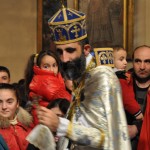 |
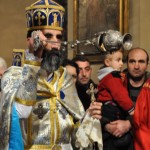 |
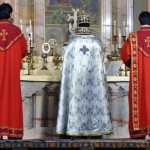 |
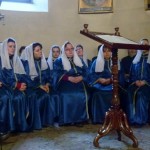 |
Later I went out of the cathedral to watch the Supreme Catholicos, Garegin II arriving at the cathedral from his palace to bless the church-goers.I also saw many impressive ancient khatchkars along the main pathway.
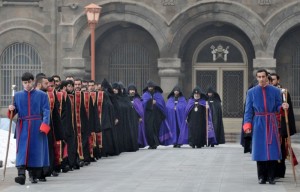 |
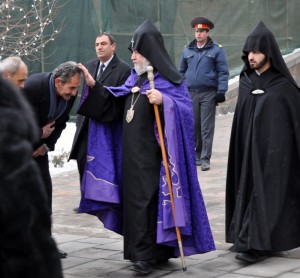 |
The second stop was the ruins at Zvartnots. Catholicos Nerses II the Builder sponsored the construction of this extraordinary cathedral which housed the relics of St Gregory the Illuminator. The building was round with a hood-shaped dome 45m high and it collapsed in an earthquake in 930. Today, one can only find an arc of carved pillars and a massive floor and many stone fragments. Next to the cathedral, there are ruins of the palace of the Catholicos, a roman bath, winery and a remarkable 6000-year old stele with inscriptions.
We visited Tsitsernakaberd (Armenian Genocide Memorial Park and Museum). The museum lies underground in a grey stone hall with lots of photographs telling the world about what had happened from the massacres of 1896 and 1909 under the Ottoman Empire and the arrest and subsequent murder of community leaders and intellectuals on April 24, 1915 which marked the beginning of the tragedy. It is said that 1.5 million Armenians fell victims causing the death of a million while the remaining survivors scattered all over the world. The memorial consists of a broad pathway flanked by a 100m-long wall engraved with the names of massacred communities leading to a 40-m high spire next to a circle of 12
basalt slabs leaning over to guard an eternal flame. Turkey has always denied what happened to the Armenians. The relationship between the two countries has been strained and the border remains closed.
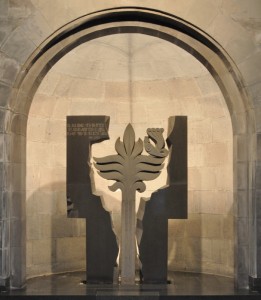 |
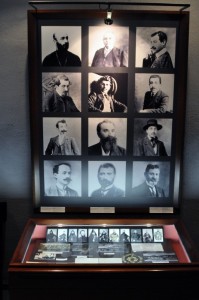 |
After lunch, we had a brief but most interesting guided tour at the Armenian History Museum. The English speaking guide is funny and knowledgeable. I enjoyed my second visit as I was able to appreciate the exhibits and the history of Armenia more with the guide’s explanations.
In the evening, we had a sumptuous meal in a tavern with Armenian singing. A nice beginning of our trip!
Day 8: Yerevan – Khor Virap–Ashtarak –Yerevan (80km)
We drove to Khor Virap located some 30km outside Yerevan. The monastery situated in the Ararat valley facing the Mount Ararat was first built the 4th century during the reign of the Arshakids dynasty. St Gregory the Illuminator was imprisoned in a dungeon there for 13 years before the king Trdat was converted to Christianity in 301.It is an important pilgrimage site. We climbed a 60-m steep ladder to reach the dark dungeon.
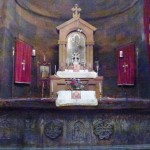 |
The next church we visited was the Karmravour Church built in the 7thcentury. It is one of the smallest churches in Armenia and its original red tiles are still found on the roof! Most amazing!
We then had a folklore theatrical performance presented by a heritage preservation school set up by a cultural – educational NGO since 1997. Many of the performers are children and their lively performances introduce us to their traditional rituals. They served us lunch which was simple but wholesome!
We finished our lunch around 3pm and proceeded to a brandy factory which was first founded in 1887 by a merchant Nerses Tairyants. At the International Exhibition in Paris in 1900, the brandy received the Grand-Prix and the legal right to be called ‘cognac’. The tour was interesting but the highlight was the tasting session when we were presented with three glasses of cognac of 3, 10 and 20-year vintage. The cognac is nice and smooth. It’s a pity that I could only finish the glass containing the 20-year old cognac and could not bring the spirit back with me!
Before going to a local restaurant for dinner, we went to see the statue of Mother of Armenia and strolled along the Cascade both of which are landmarks of Yerevan.
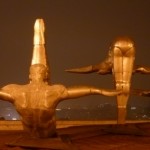 |
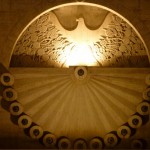 |
Day 9: Yerevan – Garni – Yerevan
We decided to revisit the Cascade before the tour started. There are five recessed fountains along the Cascade some with sculpted panels and postmodern khatchkars. It leads up to a monument commemorating the 50th anniversary of Soviet Armenia but the top section was unfinished when independence came in 1991. Gerald L. Cafesjian, an American Armenian has taken over the project. Several modern sculptures i.e. Cat
and Roman Warrior by Fernando Botero now liven up the area. Work is still in progress and one day there will be an art gallery at the top of the Cascade.
The short walk from the Republic Square to the Cascade is most enjoyable. We saw statues of many noteworthy personalities associated with the city at the parks and open space close to the opera house. The statue of Komitas, a monk, a composer and founder of the Armenian modern classical music, is most impressive. He lost his mind after witnessing the genocide in 1915 and died in Paris in 1935.
Our first stop was the Matenadaran Museum which has preserved some 17000 manuscripts and 100000 medieval and modern documents.
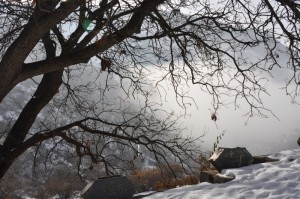 It was a cold day. The road was covered in snow when we approached the cave monastery at Geghard (a World Heritage Site) as it is located on higher ground. The name ‘Geghard’comes from the most revered relic of the Armenian Apostolic Church: the spear that one of the Roman guards had used to pierce the rib of the crucified Christ which was once kept here. It is now housed in the holy treasury at Echmiadzin.
It was a cold day. The road was covered in snow when we approached the cave monastery at Geghard (a World Heritage Site) as it is located on higher ground. The name ‘Geghard’comes from the most revered relic of the Armenian Apostolic Church: the spear that one of the Roman guards had used to pierce the rib of the crucified Christ which was once kept here. It is now housed in the holy treasury at Echmiadzin.
The monastery is said to be founded in the 4th century and the most ancient of the cave churches, St Gregory’s dates back to the 7th century. There are two main churches inside the monastery walls. Surp Astvatsatsin (Holy Mother of God) was built by the family of the Zakarian prince in 1215. The adjoining vestibule which is larger than the church dates from 1215 to 1225. The chapels are rock-hewn. The right-hand chapel constructed in
1263 includes the four-column burial chamber of Prince Papaq Proshian and his wife. Then we climbed up a flight of steps outside to reach another church which is also carved out of the rock with perfect acoustics. There are numerous remarkable khatchkars.We had a
fantastic time watching the monastery against ever changing background of mist, snow and a blue sky!
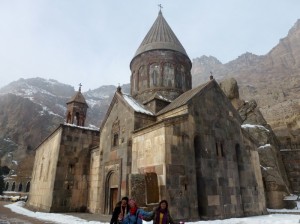 |
We proceeded to a popular local restaurant owned by an artist/photographer for lunch. It was interesting to watch the baking oflavashin
a clay oven. For the first time on this trip, we had nice grilled trout. I had three big pieces as I missed seafood.
Our next stop was the Garni Temple, dedicated to Helios, the Roman god of the sun was first built by King Trdat I in the 1st century. After the Armenia king adopted Christianity, the temple became the summer residence of the royal family. There are remains of a roman bath and the original mosaic depicting the goddess of the ocean is now displayed in the History Museum in Yerevan.
As we had to leave for Georgia the following day, Irina took us to a local market to buy organic dried fruits. I brought a kilo of plumbs and apricots. We stopped in a candy shop where I got another kilo of dark chocolate for less than US$10!
The travel agent hosted a lavish dinner for us at a newly opened restaurant and we met Lolita, the owner of the company. She is gracious and welcoming.
Day 10 (Wednesday, December 21): Yerevan – Lake Sevan – Haghpat – Tbilisi, Georgia (270km)
The weather finally improved and we saw a photogenic Lake Sevan surrounded by snow-white mountains and a blue sky! The 940-square kilometres lake taking up 5% of Armenia’s surface area is about 2000m above sea level. It is the second highest fresh water lake in the world. Sevanavank (Sevan Monastery) perched on the hilltop of the peninsula affords commanding views of the lake. There are two churches namely Church of the Apostles and the Church of the Holy Mother of God with a courtyard filled with khatchkars. Both churches were built by Queen Mariam in 874.
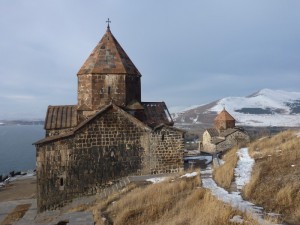 |
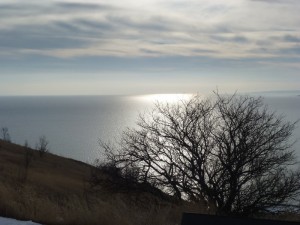 |
We had a quick tour of Dilijan which has been described as the ‘Switzerland of Armenia’. The town is surrounded by the lush oak and hornbeam forests and famed for its cute gingerbread-style structures. We had a most delicious lunch with fresh roast pork, fresh vegetables and local vodka!
After lunch, we went to the monastery at Haghpat which is a World Heritage Site. The complex founded by Queen Khosrvanuch around 976 and perched on the Debed Canyon, is amongst the most outstanding works of medieval Armenian architecture. One finds a magnificent bell tower, library and refectory. We had sunshine and a blue sky. Unfortunately we had to rush and I had no time to enjoy this extraordinary complex. What a pity!
We arrived at the border and crossed to Georgia at 4pm without hassles and were greeted by Elisa, our local guide for Georgia. (See notes on Georgia)
Remarks
I was totally ignorant about Armenia till December 1988 when it caught world attention following a disastrous earthquake measuring 6.9 on the Richter scale. The following year, I met two nice Armenian ladies living in Paris in a group tour to Peru and Bolivia. I spent many happy days with their families in Paris and am touched by their hospitality and warmth. In early 1990s, the conflict between Armenia and Azerbaijan over Karabakh once again raised my interest in the Caucasus region.
This trip is most educational. I now fully appreciate that Armenia is a country of stones! I am most impressed by its churches, monasteries and khatchkars, all of which were built with stones. I also learn something about its history and culture, its patron saint, St Gregory the Illuminator and the Armenia Apostolic Church.I have not fully realized the impact of Russia on Armenia till I was in Yerevan and travelled to the less
developed towns in the south which still have distinctive soviet-era feel.
But what strikes me most is the tension and strained relationship between Armenia and its neighhours (i.e. Turkey and Azerbaijan). I have visited the Nanking Massacre Memorial and the Jewish Museum in Berlin, both of which commemorate the mad killing of tens of thousands of innocent people. But the first of its kind should be the Armenian genocide in Turkey at the beginning of the 20th century. The architecture and design of the Armenian Genocide Museum are simple but most striking and impressive.
I cannot help but feeling sorry for Armenia. Despiteits long history and glorious past, it has been prey to its powerful neighbours namely Turkey, Russia and Persia for centuries. The country today is only occupying less than one-tenth of its former territorywhich stretched from the Mediterranean Sea to the Black Sea.
My innocuous day side trip to Karabakh has derailed my planned 6-day trip to Azerbaijan. I got a visa for Azerbaijan on December 26 after full disclosure of my excursion to Karabakh. But I was refused entry to the country on December 27 and the reason given was I had been to Karabakh. Will Armenia and Azerbaijan ever find a commonly acceptable solution to the problem? I am afraid there is no viable solution in sight! I think its strained relationship with Turkey and Azerbaijan has an adverse impact on both its psyche and economic development!
I admire the resilience, business acumen and craftsmanship of the Armenians. Armenia is lucky to have many patriotic Armenians living aboard who are ready to send remittances to support their poor relatives or donate for Armenia’s development. But I am afraid that Armenia may not have an easy and rosy path ahead owing to its limited natural resources and poor relationship with Turkey and Azerbaijan.


